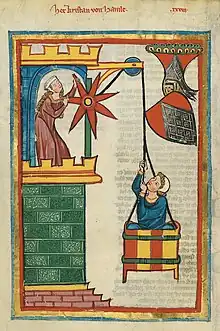
Kristan von Hamle (or Christan von Hamle) was a Middle High German poet from Thuringia who flourished in the mid-thirteenth century.[1] Nothing is known about his life or his family, as he has not been identified in any documentary record.[2]
Six "pleasing" (gefälligen),[3] yet unoriginal songs of the Minnesang (courtly love) tradition are attributed to him.[1] His main influences were Heinrich von Morungen, Walther von der Vogelweide and Gottfried von Neifen.[1] All of his work is preserved in the Codex Manesse.[2] There he is depicted in a barrel being winched up into a castle by a lady.[2][4] The image is based on the legend of Virgil in the basket, although it may be that, unlike Virgil, Kristan actually reaches the lady's room.[5]
The German philologist Jacob Grimm had, according to his own account from 1850, his first encounter with medieval German literature when in 1803 he picked up a copy of Johann Jakob Bodmer's Minnelieder in Karl von Savigny's library and opened it to the "poems in a curoius, barely comprehensible German" of Kristan von Hamle and Jakob von Wart.[6]
Works
- Der meie kumt mit schalle[2]
- Ich bin der, der lieben liebu̍ mere singet, a dawn song,[2] in which the watchman asks God's blessing on the adulterous couple[7]
- Ich wolte, daz der anger sprechen solte[2]
- Mit froͤlichem libe, mit armen umbevangen[2]
- Wol mich des sliessens, des si slos[2]
- Wunneclichen sol man schowen[2]
References
- 1 2 3 Henry Garland and Mary Garland (eds.), The Oxford Companion to German Literature, 3rd ed. (Oxford University Press, 1997), s.v. "Kristan von Hamle".
- 1 2 3 4 5 6 7 8 9 Simone Leidinger (2021), "Christan von Hamle", in Manuel Braun, Sonja Glauch and Florian Kragl (eds.), Lyrik des deutschen Mittelalters.
- ↑ Wilhelm Wilmanns (1879), "Hamle, Kristan von", Allgemeine Deutsche Biographie (in German), vol. 10, Leipzig: Duncker & Humblot, p. 477.
- ↑ Henry Hope, "Miniatures, Minnesanger, Music: The Codex Manesse", in Helen Deeming and Elizabeth Eva Leach (eds.), Manuscripts and Medieval Song: Inscription, Performance, Context (Cambridge University Press, 2015), p. 185.
- ↑ Jan M. Ziolkowski and Michael C. J. Putnam (eds.), The Virgilian Tradition: The First Fifteen Hundred Years (Yale University Press, 2008), p. 461.
- ↑ Cay Dollerup, Tales and Translation: The Grimm Tales from Pan-Germanic Narratives to Shared International Fairytales (John Benjamins, 1999), p. 3.
- ↑ Jonathon Saville, The Medieval Erotic Alba: Structure as Meaning (Columbia University Press, 1999), p. 98.